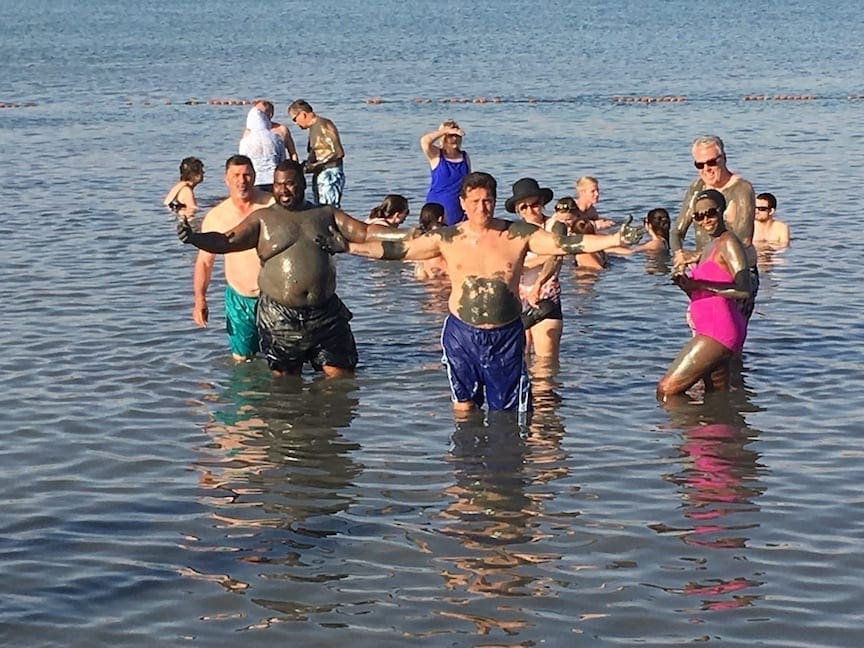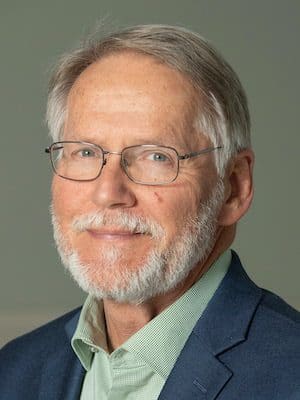Friday began with another crack-of-dawn wake-up call for the Campbell University Divinity School/Nurturing Faith Experiences group traveling in Israel, Jordan, and the West Bank. After two days in Jordan, including a delightful stay in the new spoil-you-in-a-minute Kempinski Hotel in Aqaba, we set out to cross the border back into Israel at Eilat, a port city reportedly first developed by Solomon, with help from Phoenician sailors hired from King Hiram, of Tyre (now Lebanon).
Our arrival the previous afternoon had been marked by a major dust storm blowing in from Saudi Arabia and making visibility almost nil: there was so much dust in the air that a brief shower practically rained mud, with every drop hitting the bus’s windshield leaving a muddy streak.
The crossing was surprisingly uneventful, and we were soon on the road up the Arabah Valley, with the mountains of Edom (in Jordan) to our right, and mountains of the Sinai range to our left, with Egypt just beyond. As we approached the Dead Sea two hours later, we stopped for pictures of a rock formation known as “Lot’s Wife,” after the story Lot and his wife and two daughters fleeing the city of Sodom (Genesis 19:15-26). Despite being warned not to look back at the flaming city, Lot’s wife turned to look, and was reportedly turned into a pillar of salt.
 Soon after, we passed large plants that refine magnesium and potash from the Dead Sea. The water contains about 34 percent salt (a mixture of sodium chloride and other minerals), seven times more than the ocean. It is pumped into shallow pools where the water evaporates, leaving the powdered residue behind, which is then refined.
Soon after, we passed large plants that refine magnesium and potash from the Dead Sea. The water contains about 34 percent salt (a mixture of sodium chloride and other minerals), seven times more than the ocean. It is pumped into shallow pools where the water evaporates, leaving the powdered residue behind, which is then refined.

In the synagogue at Masada, where buried scriptures were found — with the “dry bones” story of Ezekiel 37 on top.
In time we arrived at Masada, where we rode a jam-packed cable car to the top of the low mountain where Herod the Great had built a fortress including two palaces in case he needed to hide out from Cleopatra or another enemy. We took in the site itself, along with spectacular views of the Dead Sea to the east and the mountains of the Negev to the west. Down below, we could see the clear outlines of camps and siege walls set up by the 10th Roman Legion, sent to quell the last remnants of a Jewish rebellion against Rome in 73 CE.
From Masada we continued north to En Gedi, where a strong spring originating in a high mountain waterfall still flows as strongly as it did when David hid from Saul there, and confronted him in a cave (1 Samuel 24). Miriam Phillips read the story and led us in a devotion before we made our way to the lowest of the falls and gave people a chance to put their feet in the water.

Miriam Phillips challenging participants to wait for God’s timing while reflecting on David’s experience in 1 Samuel 24.
Our next stop was Qumran, where we caught a quick glimpse of Caves 4 and 5, where many of the Dead Sea Scrolls were found – and we finally got around to eating lunch at 3:45 p.m. The hard part was over.
From Qumran we drove to a spa near the northern end of the Dead Sea, where more than half of the group ventured into the muddy waters, where it is impossible for a human to sink, and one could easily lie on his or her back and read a newspaper while floating.

Several participants enjoyed the mud as much as the water of the Dead Sea: it is reputed to be good for the skin.
After an hour or so of either floating or watching, we loaded up for the final leg of the day, a long uphill drive into Jerusalem. With music professor and operatic soprano Susan Roe leading us, we sang “The Holy City”as we drove out of a tunnel, turned right, and caught our first sight of the Old City and the golden Dome of the Rock sitting upon Temple Mount.
We ended the day at Ramat Rachel, a hotel run by a kibbutz of the same name: though not as ritzy as our accommodations in Jordan, it is a fine hotel with good food – and the best thing is that we don’t have to move our luggage again until we leave on Tuesday morning.
Tomorrow: the Mount of Olives, the Palm Sunday Road, and Bethlehem.
#CUDS_NFtour2017





